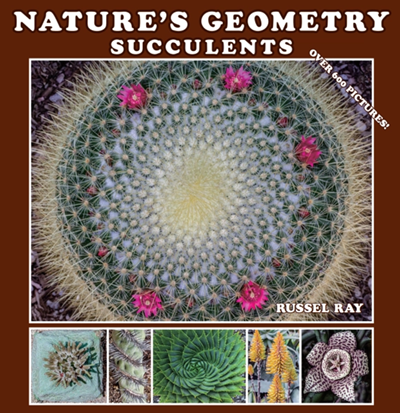 Nature’s Geometry: Succulents
Nature’s Geometry: Succulents
 Critique by Jendi Reiter
Critique by Jendi Reiter
Gardening aficionado Russel Ray takes readers on a deep dive into his special interests in mathematics and cacti in his colorful photo book, Nature's Geometry: Succulents.
Though I'm the Grim Reaper of houseplants, I take delight in the profusion of sedum and stonecrop varieties at the garden store every spring, and usually can't resist bringing one home. They are truly wonderful plants because of their hardiness and their complex leaf rosettes that last far longer than floral blossoms. So I already had a certain bias in favor of Russel's subject!
In Nature's Geometry, Russel introduces us first to the mathematical patterns that recur across hundreds of plant species, and then to some of his favorite cacti, agave, euphorbia, cycads, sedum, and related plants that he has cultivated or observed in Southern California. One senses his personal affection for some of these sample plants, like old friends that he's lived with for years. His enthusiasm gives warmth to a book that becomes quite technical in spots, as he goes into the equations behind the Fibonacci sequence and the Golden Ratio.
Nature's Geometry could appeal to several niche audiences who would all engage with it in different ways. Gardeners will get ideas about new species to plant. Middle and high school classrooms could use the book to make a math lesson come alive, or inspire a botany project. Puzzle-lovers will simply enjoy finding the geometric shapes in the photographed plants' growth patterns.
The photographs had a good variety of composition styles, from close-ups to wide shots of artistically arranged garden beds. The range of plants catalogued was impressive. Here and there, the photo galleries became repetitive and could have been edited down. The text was mainly typo-free and well-written. Russel added a human interest element by alluding to a difficult childhood whose bright spot was his grandmother and her garden. However, the phrase "wise old grandmother" was repeated way too often.
The colorful photos would have been shown off to better advantage if the pages had been glossy instead of matte, but perhaps that would have made the book too expensive. The compact paperback edition is convenient for taking along on a plant-identifying trip to a botanical garden or plant store. What can I say, I'm a sucker for succulents!







